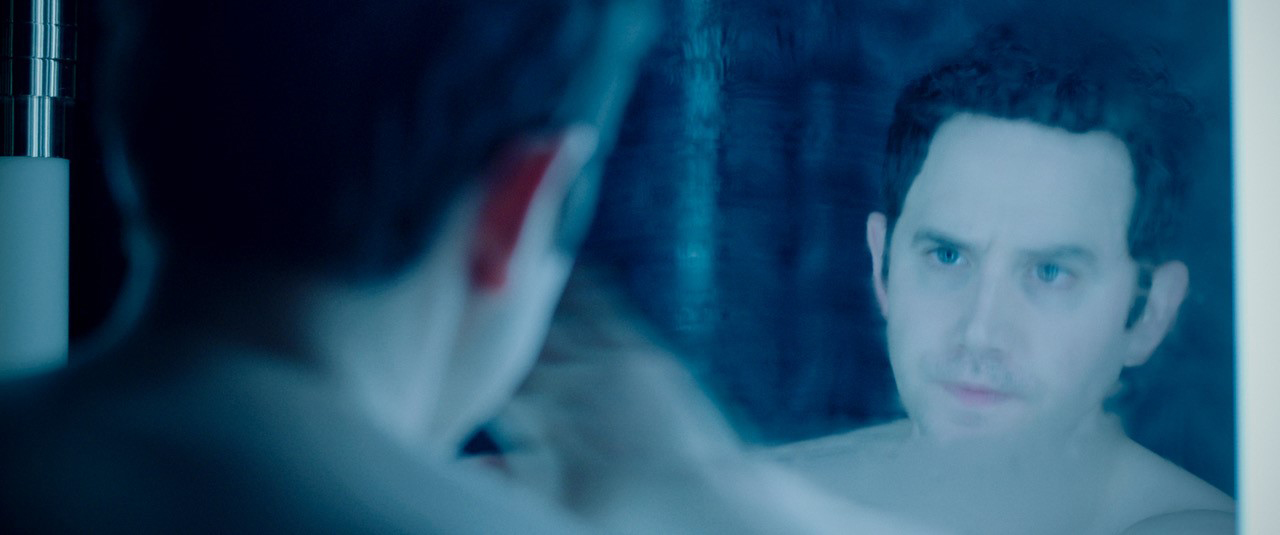Impossible Monsters (2019)
Rated R

In the first scenes of Impossible Monsters, an attractive woman passes through a narrow alleyway, making her way to mysterious lounge and into a hidden room. The way the tracking-shot scene is lit and tightly framed, backed by a crescendoing soundtrack, evokes a creepy dreamlike quality. The scene that immediately follows is the opposite: clean and clear and shot close up. Now, the woman’s grooming herself before the bathroom mirror … until she gets the urge to start pulling out her teeth in a bloody mess. It’s soon revealed as a nightmare. So, we’ve gone from a dreamlike scene that was actually reality (we later learn), to a reality-like scene that’s actually the dream. This blurring of waking and dreaming moments will pervade this cerebral thriller. Characters often occupy scenes walking a knife’s edge between what’s real and imagined.
 Director Nathan Catucci has seeded his film in those opening sequences. Now, we are introduced to other main characters.
Director Nathan Catucci has seeded his film in those opening sequences. Now, we are introduced to other main characters.
Otis (Dónall Ó Héalai) is a brooding, laconic painter whose artwork seems borne from a landscape of nightmares. For me his work evokes body horror. He sits alone in a small diner that’s obviously influenced by Edward Hopper’s iconic “Nighthawks” painting, but this might be a dream. Otis is suffering from insomnia, you see, which is affecting his work. He’s referred to a second character, Rich Freeman (Santino Fontana), a college psychology professor specializing in sleep paralysis. Into Rich’s class walks Jo (Devika Bhise), the woman from the opening. Soon, Rich has secured grant money for a group study on the sleep disorder, which ultimately includes Jo and Otis.
Two important minor characters include, Charlie (Chris Henry Coffey) and Leigh (Natalie Knepp). He is a professional rival to Rich, who is revealed to have deeper, darker motivations as the film unspools. She is social worker, a quiet cutie who falls for Rich, and seems to harbor secrets.
With the characters in place, the plot begins to spin them in and out of each other’s orbits, even as reality and dreams began to overlap. We are certainly primed for a lover’s triangle, as each of the males are drawn to Jo; she too is attracted to Otis’ dark, reckless persona and Rich’s comforting intellect. Did I mention that Jo is a student by day and an escort by night? Or that there’s a possible serial killer on the loose in the city? Rich is repeatedly courted by another university through a former colleague. There’s a sense that this represents a road not taken by Rich, and in hindsight might have been his best bet.
Catucci’s film is mainly a psychological drama, but eventually its thriller aspects kick in when one of the characters is murdered and another is framed for the death. Indeed, all along there have been sinister character motivations beneath the proceedings, but only Charlie’s are made manifest. The other characters—often facing themselves in the mirror—remain ambivalent throughout, struggling with regrets or secrets that strike out at them from their dream states. A dogged detective on the case (Geoffrey Owens, The Cosby Show) may have bitten off more than he can chew.
The cast is very good, with each actor finding the right notes at portraying the duality of their characters’ beleaguered realities while toying with their darkest natures in the dream worlds. Fontana is particularly good as a seemingly stable, straight-laced man whose darker nature makes us bristle precisely because we buy into his fundamental goodness. Bhise’s Jo could have a movie of her own. Her character is smart, but reckless, icy, but vulnerable.
The sound and camera work are superb. The look of the film is exquisite. Whether it’s beautiful college campus architecture or slick art gallery fetes or ominous sex lounges, the cinematography shines. The beauty of reality is repeatedly contrasted with off-kilter atmosphere (desaturated tones, snakes, slow motion) of dream worlds.
You might not get all the answers you’re looking for, or even those the characters are seeking, but like a dream, Impossible Monsters has an intangible texture that lingers even after it has ended.

| Marvin Brown’s Movie Review Archive
Social tagging: art > bloghouse > Devika Bhise > Dónall Ó Héalai > dreams > film review > Geoffrey Owens > Impossible Monsters > Marvin Brown > Natalie Knepp > Nathan Catucci > psychological thriller > Santino Fontana > sleep paralysis




